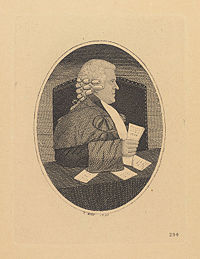
William Bannatyne, Lord Bannatyne
Encyclopedia

Biography
The son of Mr. Roderick Macleod, writer to the signet and Isabel (fl.Floruit
Floruit , abbreviated fl. , is a Latin verb meaning "flourished", denoting the period of time during which something was active...
1736–1744), daughter of Hector Bannatyne of Kames. He received a liberal education, and was admitted advocate, January 22, 1765. On the death of Lord Swinton, in 1799, he was promoted to the bench, and took his seat as Lord Bannatyne.
Among his intimate friends were Henry Mackenzie
Henry Mackenzie
Henry Mackenzie was a Scottish novelist and miscellaneous writer. He was also known by the sobriquet "Addison of the North."-Biography:Mackenzie was born in Edinburgh....
, Robert Cullen
Robert Cullen
is a Japanese footballer plays for VVV-Venlo.-Personal life:Robert is known to his teammates and family as "Bobby". He is the son of a Northern Irish father and a Japanese mother.-Club career:...
, William Craig
William Craig
William "Bill" Craig was a Northern Irish politician best known for forming the Unionist Vanguard movement.-Early life:...
, Hugh Blair
Hugh Blair
Hugh Blair FRSE was a Scottish minister of religion, author and rhetorician, considered one of the first great theorists of written discourse....
, Erskine and Alexander Abercromby. He was a contributor to the Mirror and Lounger, about the end of the eighteenth century.
He assumed the name of Bannatyne when he succeeded, through his mother to the estate of Kames in the Isle of Bute
Isle of Bute
Bute is an island in the Firth of Clyde in Scotland. Formerly part of the county of Buteshire, it now constitutes part of the council area of Argyll and Bute. Its resident population was 7,228 in April 2001.-Geography:...
. He extended Kames Castle
Kames Castle
Kames Castle is a castellated mansion house on the Isle of Bute, Scotland.On the shore of Kames Bay near Port Bannatyne, the castle consists of a 14th Century tower, with a house built on it in the 18th Century...
by the addition of a fine mansion house in the early eighteenth century. He sold the Kames estate in 1812 to James Hamilton, and moved to Edinburgh.
He retired in 1823, when he was knighted. He died at his home, Whiteford House on the Canongate in Edinburgh in 1833.
He collected a library of historical, genealogical, and antiquarian works, and at its sale in 1834, a set of the Bannatyne publications was purchased for Sir John Hay
Sir John Hay, 6th Baronet
Sir John Hay, 6th Baronet was a British baronet and politician. He sat as a Member of Parliament for Peeblesshire from 1831 to 1837.-References:...
, Baronet of Smithfield and Haystown, for one hundred and sixty-eight pounds sterling.
See also
- Bannatyne manuscript (Clan MacLeod)Bannatyne manuscript (Clan MacLeod)The Bannatyne manuscript is a traditional account of Clan MacLeod, consisting of 142 sheets of foolscap paper. The author's name does not appear upon it, however, it is considered to have been written by William Bannatyne, Lord Bannatyne—from who it takes its name. Lord Bannatyne was the son...
, attributed to William Bannatyne, Lord Bannatyne

